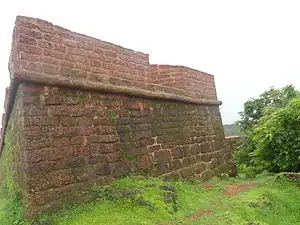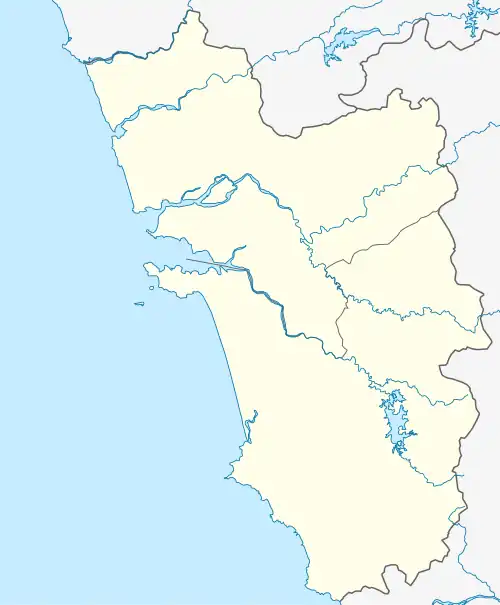Fort Santo Estevão
Fort Santo Estevão (Fortaleza de Santo Estevão in Portuguese) is a military structure erected in Santo Estevão Island, in Goa, by the Portuguese.
| Fort Santo Estevão | |
|---|---|
Fortaleza de Santo Estevão | |
| Goa in India | |
 Walls of Santo Estevão. | |
 Fort Santo Estevão  Fort Santo Estevão | |
| Coordinates | 15°32′10″N 73°57′15″E |
| Site information | |
| Condition | Good |
| Site history | |
| Built by | Portuguese Empire |
Built on the highest point of Santo Estevão Island, it was originally built as a watchtower to guard the Mandovi River, in 1550.[1] It was the easternmost defensive structure in the Velhas Conquistas. After the first Maratha incursions against Goa, in 1666-1668, during which they destroyed a local church, The structure was expanded into a small fort.[1][2] In 1683, the Marathas attacked Goa and managed to breach into the island of Santo Estevão because the corps of auxiliaries tasked with defending it fled from their enemy.[3] The Marathas captured the fort and massacred its garrison.[4]
After the annexation of the Novas Conquistas, the fort lost its military purpose.[1] It was abandoned in 1811 by decree of the Viceroy of India Dom Bernardo José Maria da Silveira e Lorena.[5]
Restoration works were undertaken on the fort in 2012.[1]
References
- Nuno Miguel de Pinho Lopes: O Sistema Defensivo de Goa, Universidade de Coimbra, 2017, pp.111-120.
- José Nicolau da Fonseca: An Historical and Archæological Sketch of the City of Goa: Preceded by a Short Statistical Account of the Territory of Goa, Thacker & Company, limited, 1878, p.288.
- Joaquim Heliodoro da Cunha Rivara, Charles J. Borges: Goa and the Revolt of 1787, Concept Publishing Company, 1996, p.225.
- António Lopes Mendes: A India portugueza: breve descrupção das possessões portuguezas na Asia, dividida em dois volumes, illustrados com 382 gravures e 7 mappas, , Volume 1, Imprensa nacional, 1886, p.63.
- Joaquim Pedro Celestino Soares: Bosquejo das possessoes portuguezas no Oriente ou resumo de algumas derrotas da India e da China, Imprensa nacional, 1851, p.32.